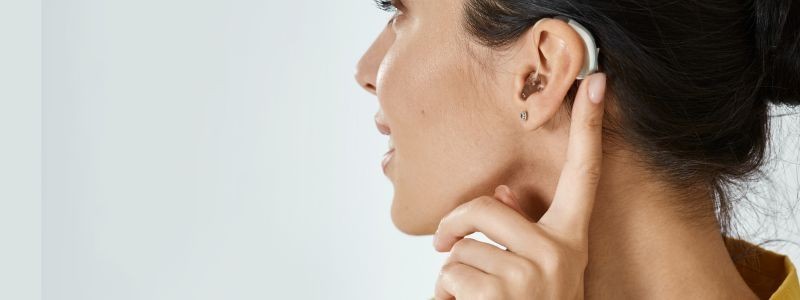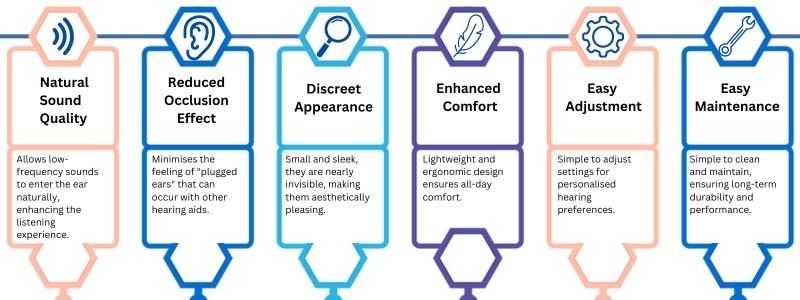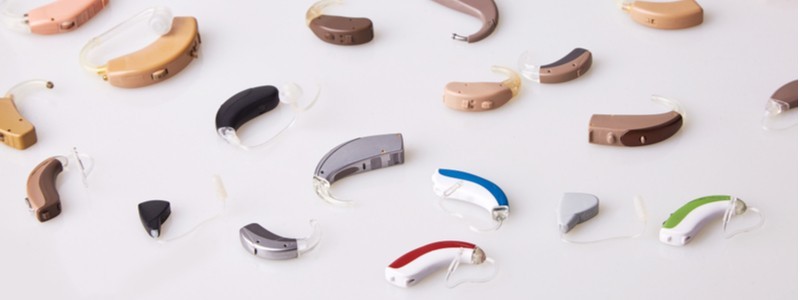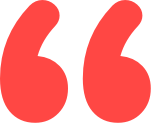
Head of Online Medical Content

Audiology Expert

Open Fit Hearing Aids
What are they, and what are the benefits?
Overview | What are they? | The technology | The benefits | The disadvantages | Open vs closed | Domes Summary
Last Hearing Aid UK Update:
Overview
Open fit hearing aids are small, Behind-the-Ear (BTE) hearing aids with a thin tube that keeps the ear canal open. This design reduces the occlusion effect, providing natural sound quality.
They are ideal for mild to moderate high-frequency hearing loss and offer comfort and discretion, amplifying high frequencies while preserving natural low-frequency sounds.
In this article, we briefly go through the benefits and disadvantages of this type of hearing aid, and the sound experienced, as well as comparing an open fit to a closed one.
Open fit hearing aids fit smaller behind the ear
Open fit hearing aids are simply the smaller or 'mini' Behind-the-Ear (BTE) and Receiver-in-the-Ear (RIC) hearing aid styles that are fitted with an open-style dome.
The sound from open fit hearing aids is transmitted straight to the ear canal through a thin plastic tube, attached to a tip that comfortably sits within your ear canal. This style of hearing device is very popular among patients.
However, they are not right for everyone, and it's important to know if they are right for you.
What are open fit hearing aids?
The 'open' refers to the earpiece not fitting tightly inside your ear canal, unlike the older style BTEs, CICs, ITCs, and ITE models. This type of earpiece is much smaller, softer, and therefore more comfortable.
They are commonly successful with those who have normal, low-frequency hearing and those with mild to moderate hearing loss.
This type of hearing aid tip does not obstruct the ear canal like traditional hearing aids, giving you a more natural sound experience and an 'open' feeling.
This is because the sound and air can still enter your ear as normal, whilst amplified sound from your hearing aid goes through the tip.
BTE digital hearing aids have had bad press for years, as people can't shake off the 'brown banana' of past devices. In reality, this particular style has developed and evolved, and there are so many slimmer and more sophisticated BTE hearing aid designs available today.
Since open fit hearing aids were introduced to the audiology industry and consumers, we believe that the number of Behind-the-Ear (BTE) hearing aids being sold has naturally increased. A decades-long negative attitude towards this style of device is slowly being reversed.
Related reading: Types of hearing aids

Open Fit Hearing Aids
Why are open fit hearing aids so popular?
The technology behind open fit hearing aids
We believe this new renaissance of popularity is mainly due to consumers being impressed with the natural sound of the open fit hearing aid technology, as well as the style being more comfortable on the ear.
They are a more modern alternative, and therefore more cosmetically appealing. Open fit hearing aids are more comfortable to wear all day, lighter, reduce complaints related to occlusion, and decrease feedback.
People are also impressed that the fitting time is a lot quicker because the audiologist does not need to take impressions of their ears to create ear moulds to suit their ear shape.
They could effectively walk away with their hearing aids on the day, rather than wait a week for the ear moulds to arrive and then be fitted.
What are the benefits of open fit hearing aids?
- They are aesthetically pleasing, more subtle, and the most discreet BTE hearing aids available in the industry.
- They are more comfortable due to the soft dome that doesn't block your ear canal. Therefore, you don't get that 'plugged' feeling or any discomfort during your day of wear.
- They are also quick to fit, due to the earmould not needing to be tailor-made.
- They provide a natural sound experience due to their non-occluding profile. Your sound freely enters your ear canal naturally.
What are the disadvantages of open fit hearing aids?
- Those with steeply sloping hearing loss, flat hearing loss, or more than mild hearing impairment might find open-fit hearing aids lacking in amplification. This can result in challenges in hearing clearly, particularly in noisy settings.
- Open-fit hearing aids let in more ambient sounds, which limits the device's ability to focus on specific sounds.
- Earmolds offer a more personalised fit and better retention than dome tips. They are custom-made to fit the shape of your ear comfortably. Although open dome tips come in various sizes to fit many wearers, they may not be ideal for everyone.
Open fit hearing aids vs closed fit hearing aids
What is the difference between open fit hearing aids and closed hearing aid fittings? An open fitting means that the sound waves get to your eardrum more naturally because the hearing aid tip doesn't fill your entire ear canal.
Commonly, you will hear your louder soundscape more naturally, too. An open hearing aid design also gives your ear canal more ventilation.
On the other hand, a closed hearing aid fitting fills most of your ear canal with either an earpiece or an ITE hearing aid. With this fitting, sound transmits directly to you to allow for a full range of hearing aid features.
![]()
A quick introduction to closed and open hearing aid domes
There are two different types of hearing aid domes, which alter the sound quality of your hearing aids and hearing experience. The one you opt for really depends on the level of your hearing loss and what your audiologist advises.
A closed-style hearing aid dome is one full piece of plastic that covers the receiver and is inserted within your ear canal. An open-style hearing aid dome has several openings along with the dome.
The openings assist in preventing the occlusion you can be challenged with and provide amplified sound.
![]()
Open Fit Digital Hearing Aids
Open fit hearing aid reviews
What do we think of open fit hearing aids?
Currently, open fit hearing aids are highly sought after, potentially offering the comfort and clarity of sound you've been seeking.
Their sleek design is known to deliver a natural sound quality as they maintain an open ear canal, alleviating the sensation of having "fingers in your ears". These hearing aids amplify only the necessary frequencies, enhancing their effectiveness.
Open fit hearing aids are commonly favoured for their enhanced comfort. Despite resembling Behind the Ear (BTE) aids in appearance, they are notably smaller behind the ear.
A slender tube connects this component to the ear canal, which is secured by a soft, small silicone tip, eliminating the need for an ear mould.
In our experience, our patients have always loved the natural sound of the Oticon hearing aids, such as Oticon Real and Intent. In regard to the cost of open-fitting hearing aids, they are usually the same as standard hearing aids, but it all depends on the hearing aid provider you use.
As they do not completely block the ear canal, open fit hearing aids are easier to look after. This is because the design allows for better airflow, reducing the buildup of earwax and moisture.
However, it is still important to keep them dry, store them in a safe place when not in use, and clean them often with a soft, dry cloth. For information on how to look after open fit hearing aids, click on the button below to download the brochure from Action on Hearing Loss.
Summary
To summarise, open fit hearing aids offer discreetness, natural sound quality, and comfort, particularly for mild to moderate high-frequency hearing loss. However, they may not be suitable for severe hearing loss or those with significant ear canal blockage.
It is also important to remember that regular maintenance and adjustment are necessary for optimal performance and satisfaction.
Why Choose Us?
- FREE Hearing Tests
- Best Hearing Aids and Prices
- FREE Aftercare for Life
- FREE Home Visits
- 200+ Local Audiologists
- 60 Day Money Back Guarantee
Want to know whether open fit hearing aids are right for you?
Open fit hearing aids offer numerous benefits, including natural sound quality by allowing low-frequency sounds to enter the ear naturally, reducing occlusion effects.
They provide enhanced comfort due to their lightweight design and are discreet, making them nearly invisible. They are also easy to adjust and maintain.
If you're interested in this type of hearing aid, call one of our audiologists for free on 0800 567 7621 to find out more about open fit hearing aids or other ranges on the current market.
Other articles on hearing aid advice you might like...
 The Best Hearing Aid Providers According to Which?
The Best Hearing Aid Providers According to Which?  Hearing Aids with Directional Microphones
Hearing Aids with Directional Microphones Our specialist service includes:
Do not spend hundreds of pounds without getting a second opinion from us.
Please call us on 0800 567 7621
 Not only are the prices great, but the service is fantastic! Many thanks to your team.
Not only are the prices great, but the service is fantastic! Many thanks to your team.Watch the NHS open fit hearing aid video below
What's included in our hearing aid prices?
Other pages you might find useful
Common FAQs about open fit hearing aids
What is the difference between an open fit and Behind the Ear hearing aid?
An open-fit hearing aid is a variation of the Behind-the-Ear (BTE) hearing aid with a thin tube or the Receiver-in-the-Canal (RIC) hearing aid with an open dome in the ear.
Which are better, open or closed hearing aid domes?
Open domes are generally suitable for people with mild to moderate hearing loss. Closed domes, which block more of the ear canal than open domes, help amplify low-frequency sounds and are often best for those with moderate hearing loss.
What is the efficacy of an open-fitting hearing aid?
An open-fitting reduces the hearing aid's low-frequency output by up to 30 dB below 1000 Hz while allowing low-frequency sounds from the environment to enter the ear canal directly without attenuation.
Ask the Experts
6 Morton Lane
Walkwood
Redditch
Worcestershire
B97 5QA
Latest Launch
When we refer to a product as 'Latest Launch', we mean it is the latest to be released on the market.
New
When we refer to a product as 'New', we mean that the product is the newest hearing aid model on the market.
When we refer to a product as 'Superseded', we mean that there is a newer range available which replaces and improves on this product.
Older Model
When we refer to a product as an 'Older Model', we mean that it is has been superseded by at least two more recent hearing aid ranges.
